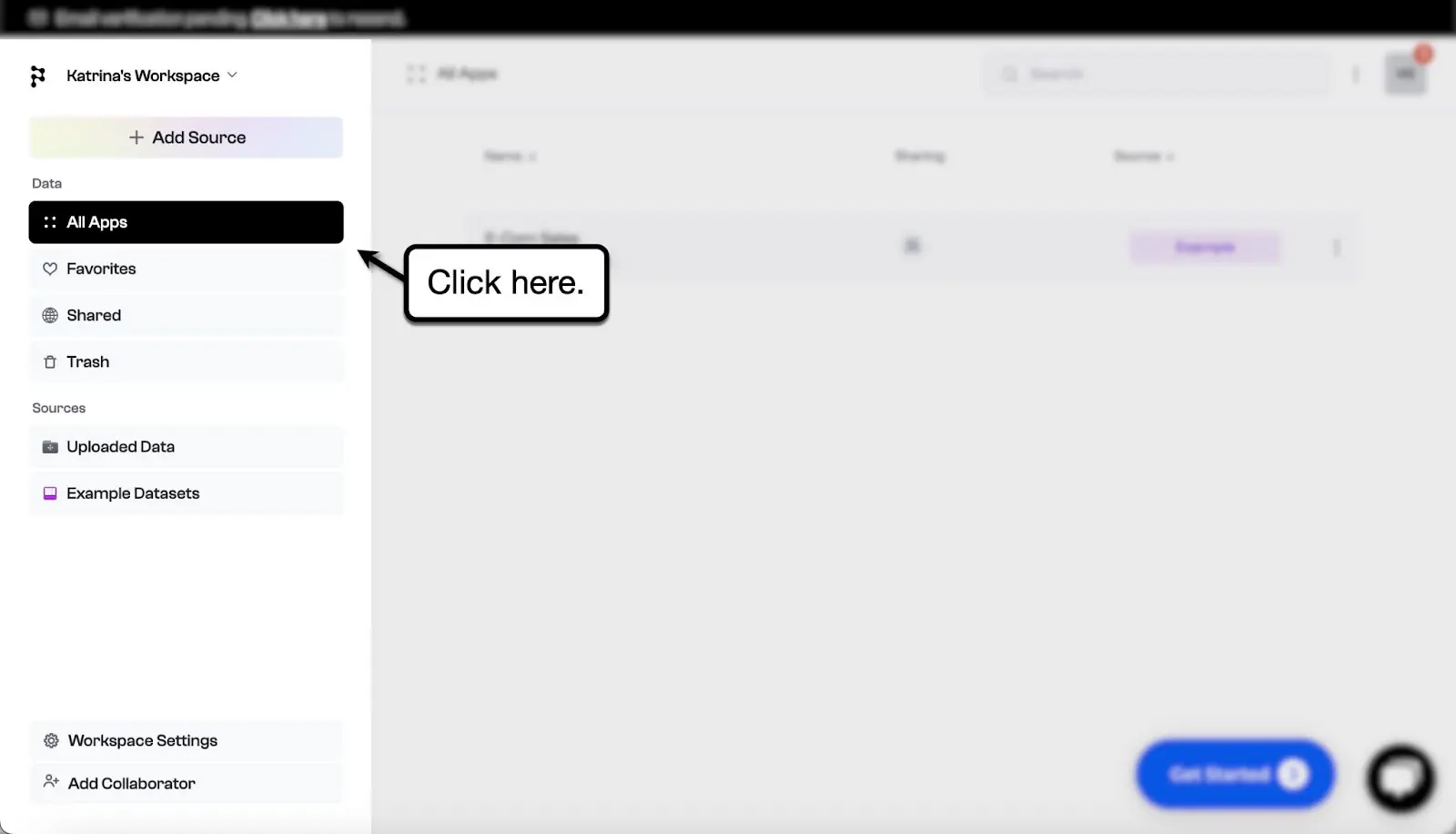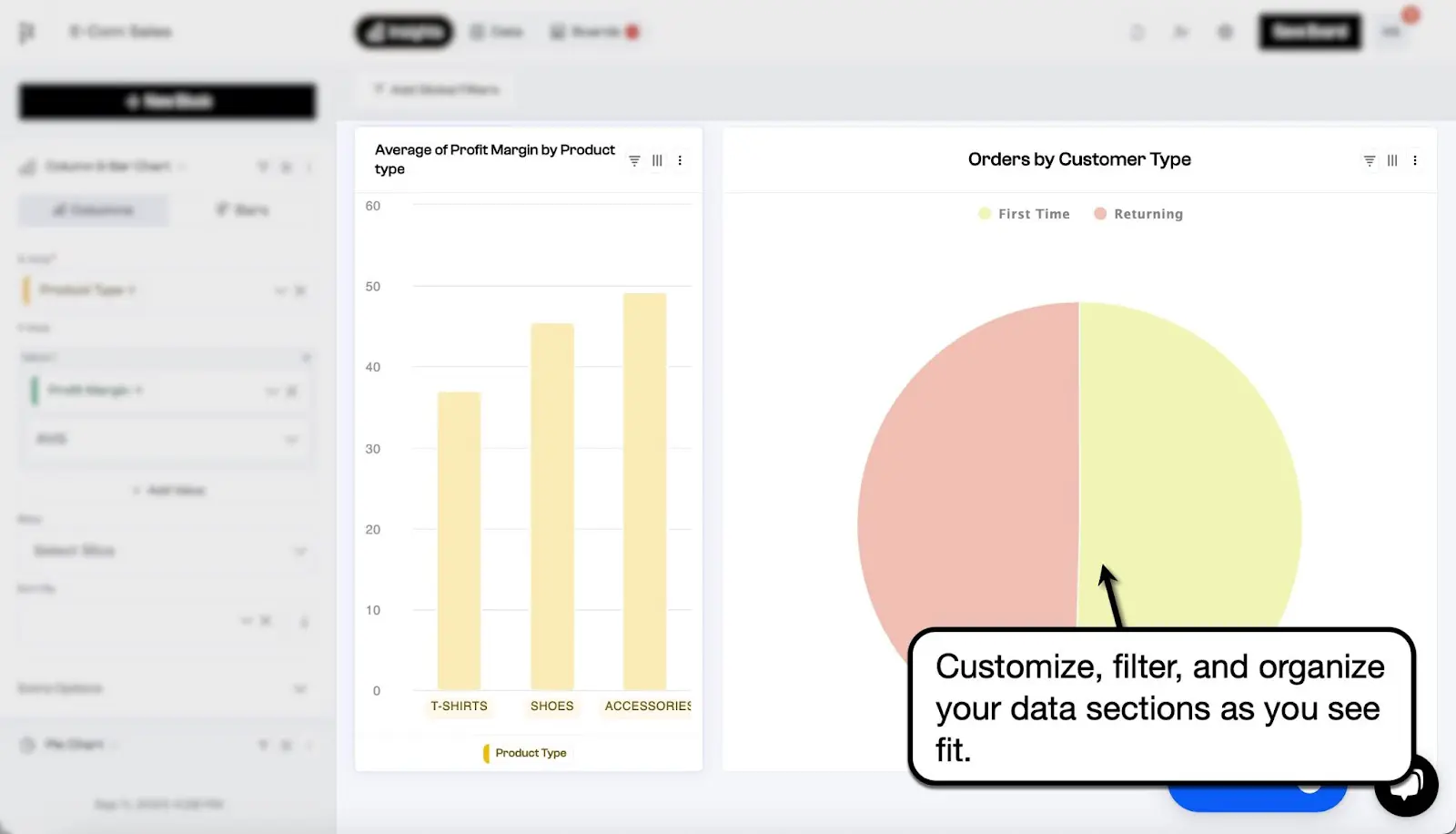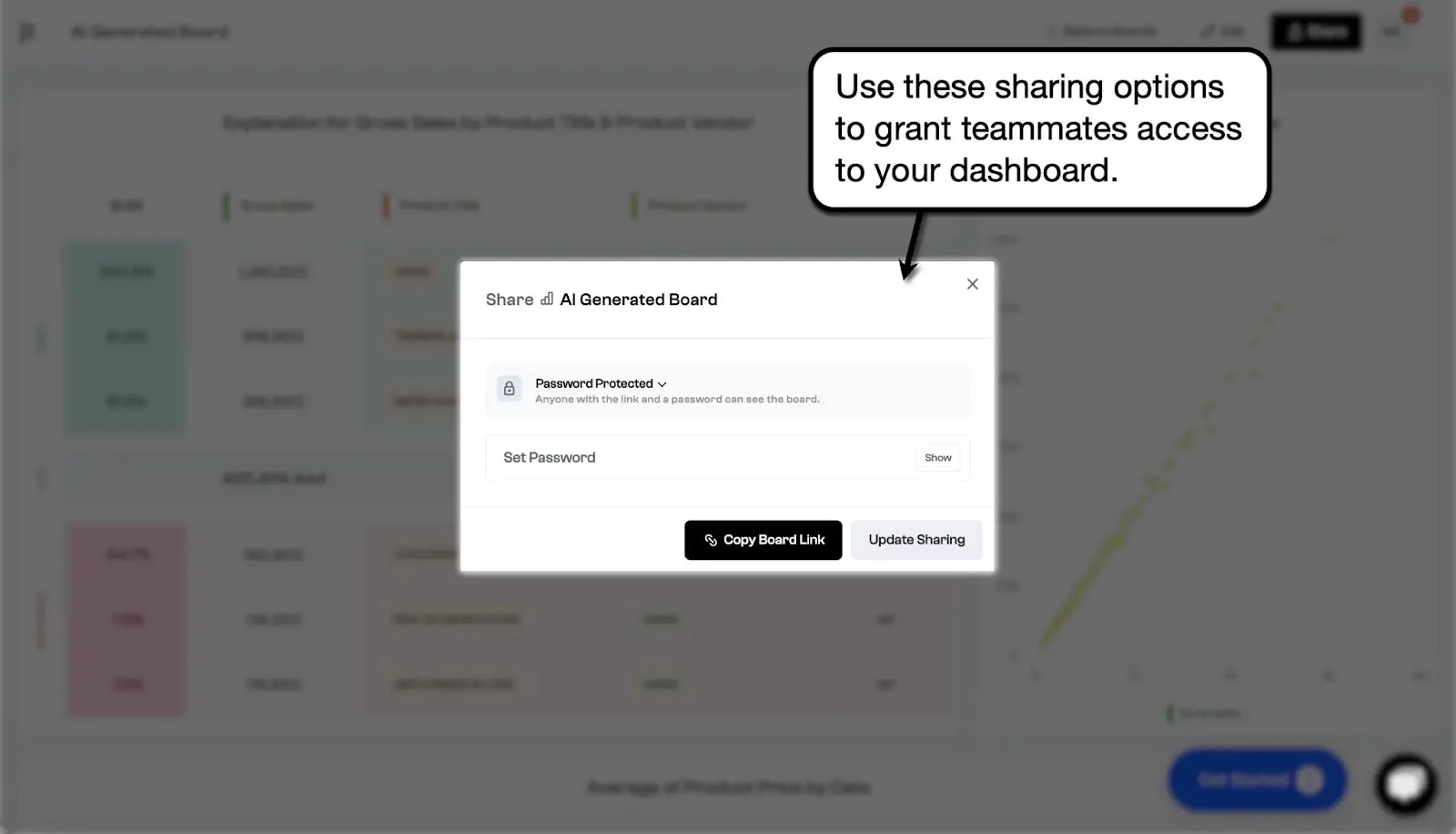E-Commerce Business Overview
Combine your Shopify, GA4, Google Ads, and Facebook data for insights across your business.
Boost eCommerce with efficient data visualization dashboards. Make faster decisions, streamline data analysis, and align with business goals. Learn more in this detailed guide!

Data visualization is a game-changer for eCommerce businesses.
A meticulously designed eCommerce dashboard empowers online store owners to make smart decisions quicker.
It helps you avoid the hassle and time-consuming task of sifting and sorting through raw, unorganized data.
Data analysis efficiency skyrockets since your dashboard only presents reports aligned with your business goals.
Continue reading this guide to learn how to build an eCommerce dashboard.
An eCommerce dashboard is a centralized hub for eCommerce business performance metrics and Key Performance Indicators (KPIs). It contains charts, tables, and other data presentation elements to turn data into actionable insights.
Data dashboards enable organizations to make data-driven decisions more reliably and efficiently.
With a Business Intelligence (BI) platform like Polymer, quickly build readable dashboards for your eCommerce team using Polymer’s drag-and-drop editor.
Polymer integrates directly with popular services like Jira, Facebook Ads, and Shopify to seamlessly import data—providing your eCommerce business with a single source of truth.
It also offers advanced, AI-powered features so you can generate instant insights, organize data, or build entire dashboards from scratch.

Here are some of the top benefits of creating a data dashboard for your eCommerce business:
Before you build an eCommerce data dashboard, you need to pin down a handful of important details to guarantee success.
First, conduct a needs analysis to ensure your dashboard produces actionable insights that help accomplish business objectives. This will also help you decide on the layout and visual elements in your data dashboard.
Begin by defining your data dashboard's purpose. In an eCommerce context, this may revolve around business objectives like increasing online sales, improving inventory management, optimizing marketing campaigns, and enhancing customer satisfaction.
Document your eCommerce analytics goals to help guide the rest of your data dashboard plan.
Most modern eCommerce platforms come with built-in analytics reporting capabilities.
Although they essentially work the same and track similar metrics, they might differ in terms of data integration and automation features. These factors affect how you build and configure your eCommerce dashboard.
As a catch-all, spreadsheet tools like Google Sheets are capable of processing data exports from almost every eCommerce platform. It supports data from a variety of file types, including XLS, XLTM, CSV, and ODS.
Google Sheets can be an intermediary between your eCommerce platform and your dashboard builder.
Alternatively, you can build your eCommerce dashboard within Google Sheets. Insert data charts, scorecards, pivot tables, and custom mathematical formulas to build a fully functional, unique data dashboard at zero cost.
Must-read: How to Create a Google Sheets Dashboard
One of the benefits of using spreadsheet software is there are no restrictions regarding the types of data you can process.
Quantitative metrics like orders made, cancellations, online store traffic, and clicks are fully supported and easy to format. Spreadsheets can also aggregate and process qualitative data like customer feedback, poll responses, and observation notes.
If you plan to create a Google Sheets KPI dashboard for your eCommerce business, be sure to identify the metrics you need to track. This lets you calculate KPIs with the right formulas and raw data.
Some eCommerce platforms only provide raw data in their reporting tools. As such, you need to organize the available data and calculate the KPIs above yourself.
Use spreadsheet software, data analysis add-ons, or BI platforms to automate the calculations for your eCommerce dashboard.
Must-read: Google Ads Landing Page Performance Dashboard Templates
As an eCommerce business, you have several options for data collection depending on your goals. These can be classified under primary data and secondary data sources.
In simple terms, primary data refers to raw insights you collected yourself—usually through traditional methods like:
Secondary data pertains to information an external entity collects, organizes, and presents. Note that this includes data from analytics tools and built-in reports from eCommerce platforms.
Below are some examples of secondary data collection:
Apart from identifying data sources, another important step in data collection is choosing the right tools for consolidating and managing multiple data streams. You can check out the free Google Sheets dashboard templates to see if you find a good match.
Alternatively, you can use Polymer for more robust data management features.
Polymer supports a handful of data sources to help centralize your data management. This includes Shopify, Google Sheets, Google Analytics 4, Facebook Ads, and Zendesk.

Once integrated, Polymer automatically raw data from your chosen data source. That means you're ready to construct your eCommerce dashboard using the drag-and-drop editor.
If your eCommerce tool isn't supported by Polymer via direct integration, compile your data in a Google Sheets dashboard first.
Must-read: Google Analytics 4 Dashboard Templates
To access your eCommerce data set, click 'All Apps' from the main menu.

Find and select your eCommerce data set to launch the Polymer editor.
In the "Insights" tab, you can translate your eCommerce data into interactive data visualizations.
Click 'New Block' to choose from several customizable visualization tools, including charts, heatmaps, scatter plots, scorecards, and pivot tables.

Below are examples of Polymer's data visualizations and their possible use cases:
Each visualization comes with its own configuration and customization options.
For example, when adding a bar chart, you can select values for your X or Y axis, sort your data, set slices, enable the trend line, and more.

Polymer also offers AI-powered recommendations to extract actionable insights from your data quickly.
Here are some recommendations you may get with eCommerce sales data sets:

Clicking an AI recommendation generates a preview of your new data section. If you're happy with the results, click 'Add to Board' to insert the section into your dashboard.
Of course, AI-powered data visualizations are also fully customizable. You may also change the layout and filters of individual data sections using the Polymer editor.

It's also worth noting that Polymer can automatically generate an entire insights dashboard in one click.
To access this feature, switch to the 'Boards' tab and select 'AI Generated Board.'

To share your dashboard with teammates, click 'Share' in the top-right corner.
From there, choose whether to share your dashboard via an embed code or direct URL. Consider creating a password for your eCommerce dashboard to keep your data secure.

Another way to share dashboards with other users is to invite them as collaborators. Head to Polymer's home page, click 'Add Collaborator,' and set up their workspace account.

Must-read: Facebook Ads Dashboard Templates
Here are dashboard report best practices and tips to help make the most out of your eCommerce data:
Must-read: How to Build a Jira Dashboard in Google Sheets
Your eCommerce dashboard should visualize critical Key Performance Indicators (KPIs) that align with your research goals. Some examples are net profit, gross sales, return rate, cart abandonment rate, and conversion rate.
Steps to creating an eCommerce dashboard:
Businesses can use spreadsheet software with data visualization tools like Google Sheets to create eCommerce dashboards. A better alternative would be a full-fledged Business Intelligence platform like Polymer.
Building a central data dashboard is an important step towards eCommerce success. And to ensure positive results, you need to use the right tools.
Polymer has everything you need to build effective eCommerce dashboards—from data collection to visualization.
Best of all, you can get started for free.
See for yourself how fast and easy it is to uncover profitable insights hidden in your data. Get started today, free for 7 days.
Try Polymer For Free




